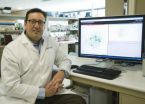The function of the vast majority of the human genome has remained largely unknown, but the Encyclopedia of DNA Elements (ENCODE) project, launched in 2003, set out to change that. Comprised of more than 30 participating institutions, including the Broad Institute, the ENCODE Project Consortium has helped to ascribe potential biochemical function to a large fraction of the non-coding genome. This work has revealed elements that act like dimmer switches, subtly turning up or down a gene's activity and influencing what parts of the genome are utilized in different kinds of cells. The team characterized and mapped out the locations of thousands of these switches and signals. More than 30 papers detailing these results appear online in Nature, Science, Genome Research, and Genome Biology this week.
"With these maps in hand, we can begin to understand why genetic variants that land in the annotated regions may predispose people to disease," said Brad Bernstein, a senior associate member at the Broad Institute and an associate professor of pathology at Massachusetts General Hospital (MGH) and Harvard Medical School. Bernstein is also a principal investigator in the ENCODE Consortium. "It turns out that many of the variants that genetic researchers have tied to various diseases – lupus, Crohn's disease, metabolic diseases, high cholesterol, and much more – sit in these regions that alter how genes are expressed in specific kinds of cells."
Researchers from the Broad, MIT, and MGH found that variants associated with autoimmune diseases such as lupus and rheumatoid arthritis sit in regions that are active only in immune cells, whereas variants tied to cholesterol and metabolic diseases sit in regions active in liver cells.
In order to generate detailed maps of the switches that lie between – and even nestled within – genes, data collection centers in the consortium amassed high-quality and comprehensive datasets detailing the function of elements in the genome. By looking across more than 140 cell types, they generated more than 1,500 datasets.
Several groups at the Broad Institute contributed to this work, including the Genome Sequencing and Analysis Program and the Epigenomics Program, which helped generate many of the datasets for the project. The term "epigenome" refers to a layer of chemical information on top of the genetic code, which helps determine when and where (and in what types of cells) genes will be active. This layer of information includes a suite of chemical changes that appear across the genetic landscape of every cell, and can differ dramatically between cell types. Researchers at the Broad and at the other ENCODE data collection centers developed ways to characterize these epigenetic "marks" across cell types.
"By bringing together computational groups from across the world and gathering all of the data generated, we can get at much more complex questions," said Manolis Kellis, an associate member of the Broad Institute, principal investigator at the MIT Computer Science and Artificial Intelligence Lab (CSAIL), and an associate professor of Computer Science at MIT. Kellis is also head of the MIT Computational Biology Group and a principal investigator in the ENCODE Consortium.
Maps and data generated through the ENCODE project have been publicly released as they have become available. With these maps, Bernstein, Kellis, and their Broad colleagues:
Recognized regions upstream and downstream of genes that control when and where a gene is turned on or off
Mapped small sequence patterns within these control regions that play important roles in region activity and disease association
Studied the differences in the behavior of genetic variants inherited from the mother or father
Grouped elements from across the genome into "neighborhoods" of similar activity that are typically associated with similar gene functions
Proposed candidate biochemical functions for the majority of genetic variants associated with disease but residing outside of protein-coding genes
The ENCODE project challenged members of the Broad's Epigenomics Program to create new tools and methods and improve data generation. "As a data production center, we take very seriously our responsibility to only let high-quality data out the door," said Chuck Epstein, who manages the Epigenomics Program. "We're constantly trying to develop better ways to know that data are high quality, and that involves developing good systems to annotate and view data."
The project also led to challenging new problems for data integration across different labs and institutions using a variety of experimental protocols. "We developed novel statistical methods and robust automated pipelines for uniform processing, quality control, reproducibility analysis and integration of massive amounts of diverse data," said Anshul Kundaje who led the data coordination efforts of the consortium and is now a research scientist at the MIT Computational Biology group. "This resulted in very high standards of data quality across the consortium as well as freely available software pipelines that we believe will serve as a valuable resource to the larger scientific community."
With epigenomic maps in hand, researchers are now turning to the next phase of the project. They will look across more cell types – each of which contain different epigenomic instructions – and will begin looking at the wiring of these switches.
"We now have a map of the genomic locations of these switches, but we don't have a map showing which switch controls which gene," said Bernstein. "What turns on the switch? And when it turns on, what gene or genes get upregulated? Having a map of the way these elements are wired and connected is a critical goal."
###
Other Broad researchers involved in this work include Tarjei Mikkelsen, Shawn Gillespie, Alon Goren, Oren Ram, Noam Shoresh, Xiaolan Zhang, Li Wang, Robbyn Issner, Michael Coyne, Timothy Durham, Manching Ku, Thanh Truong, Lucas Ward, Robert Altshuler, and Matthew Eaton. A full list of authors and ENCODE papers will be made available online.
-Written by Haley Bridger, Broad Institute
Paper cited:
The ENCODE Project Consortium. "An integrated encyclopedia of DNA elements in the human genome," Nature DOI: 10.1038/nature11247
About the Broad Institute of Harvard and MIT
The Eli and Edythe L. Broad Institute of Harvard and MIT was launched in 2004 to empower this generation of creative scientists to transform medicine. The Broad Institute seeks to describe all the molecular components of life and their connections; discover the molecular basis of major human diseases; develop effective new approaches to diagnostics and therapeutics; and disseminate discoveries, tools, methods and data openly to the entire scientific community.
Founded by MIT, Harvard and its affiliated hospitals, and the visionary Los Angeles philanthropists Eli and Edythe L. Broad, the Broad Institute includes faculty, professional staff and students from throughout the MIT and Harvard biomedical research communities and beyond, with collaborations spanning over a hundred private and public institutions in more than 40 countries worldwide. For further information about the Broad Institute, go to http://www.broadinstitute.org.
For more information, contact:
Broad Institute of MIT and Harvard
Haley Bridger
617-714-7968
hbridger@broadinstitute.org
MIT Computer Science and Artificial Intelligence Lab
Abby Abazorius
617-324-9135
abbya@csail.mit.edu
END

